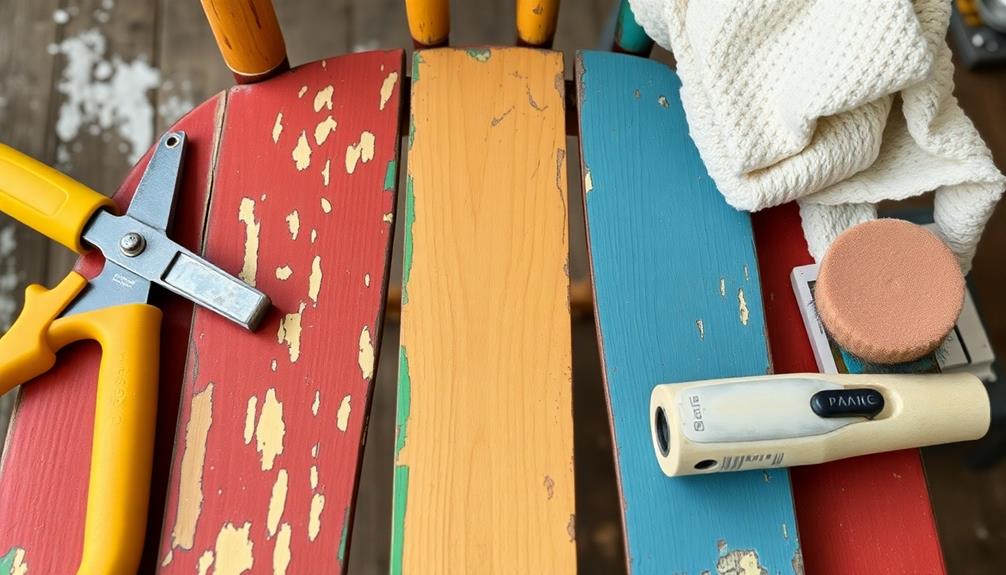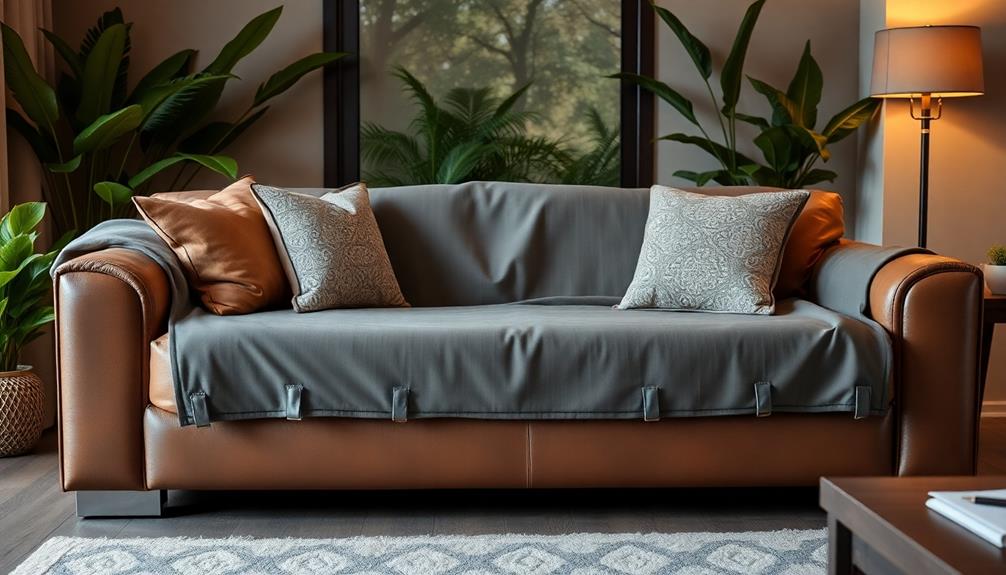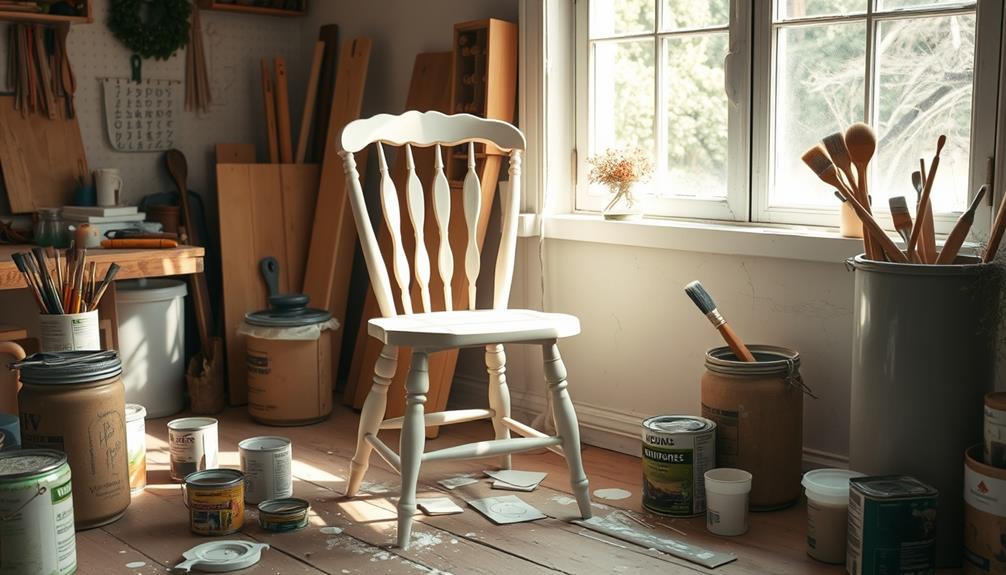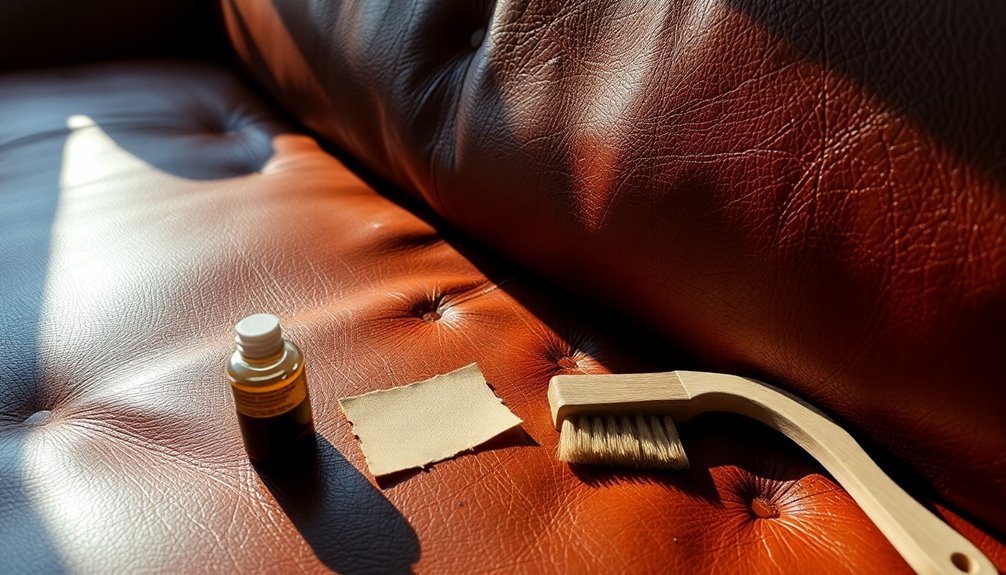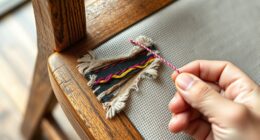When it comes to removing paint from wood furniture, it’s important to choose a method that is best suited for your specific project. You have the option to use a heat gun to soften the paint for easy scraping or you can apply a chemical stripper such as Citristrip for more intricate designs. Remember to always wear protective gear and work in a well-ventilated area. After applying the stripper, cover it with plastic wrap to help with absorption, then check for bubbling before scraping off the paint. Once the surface is clean, sand it down for a smooth finish and then apply a protective coating. There are many techniques and tools available for you to explore further. If you’re also dealing with moisture issues, it’s crucial to remove any mold from the wood furniture before refinishing. You can use a mixture of vinegar and water or a specialized antifungal cleaner to tackle the mold, making sure to thoroughly dry the surface afterwards. Once both the mold and paint have been removed, you can proceed with sanding and applying your chosen finish for a polished final look.
Key Takeaways
- Choose a suitable method for paint removal, such as heat guns, chemical strippers, or sanding, based on your furniture's condition and design.
- Always prepare your workspace with a drop cloth and ensure proper ventilation to minimize exposure to harmful fumes.
- Apply paint stripper generously, cover with Saran wrap for better absorption, and let it sit for 1 to 24 hours.
- Use a metal or plastic scraper at a 30-degree angle to lift softened paint without damaging the wood underneath.
- Finish by sanding the wood with 120-grit sandpaper, followed by 600-grit for a smooth surface, ensuring it's clean and dry before applying a protective finish.
Choosing the Right Method
When it comes to removing paint from wood furniture, choosing the right method is vital for achieving the best results. If you're dealing with flat surfaces, a heat gun can be your best bet. It quickly softens the paint, allowing you to scrape the paint away effectively.
However, be cautious; the heat can ignite nearby materials, so always work in a well-ventilated area and keep flammable items away. Additionally, it's important to take into account the impact of the cleaning method on the wood's finish and integrity, as improper techniques can lead to irreversible damage. For more information on safe cleaning practices, check out best practices for organizing prep tables.
For intricate designs or detailed areas, think about using chemical strippers like Citristrip. These paint strippers are effective for removing multiple layers without creating dust, making them suitable for indoor use.
Just remember to follow safety precautions, such as wearing gloves and a mask.
If your wooden furniture was built before 1978, it's vital to test for lead-based paint. This requires additional safety precautions, and you may need to consult a professional for safe removal.
Finally, sanding is an option for flat surfaces but can damage the wood if not done carefully. Start with coarse sandpaper and finish with finer grades for a smooth result.
Choose the method that best suits your project and guarantee a successful paint removal process.
Essential Tools and Materials
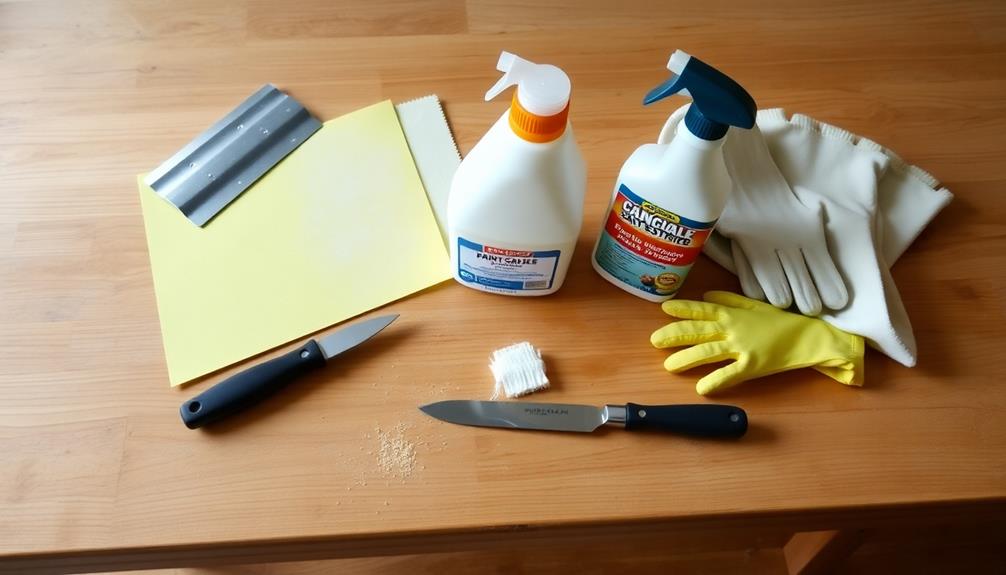
Selecting the right method for removing paint is just the beginning; having the right tools and materials on hand will make the process smoother and more effective.
Using a best airless paint sprayer can be beneficial for quick projects or touch-ups after paint removal.
Here's a list of essential items you'll need for removing paint from wood furniture:
- Heat Gun: Use this to soften paint, making it easier to scrape off. Just be cautious to prevent igniting nearby materials.
- Chemical Strippers: Products like Citristrip work wonders. Apply them using a disposable brush for an even coat.
- Metal Scraper: This tool is perfect for lifting softened paint without harming the wood underneath.
- Plastic Scraper: For delicate areas, a plastic scraper helps avoid damage while effectively removing paint.
- Sandpaper: Keep various grits on hand, from 80-grit for heavy sanding to 220-grit for a smooth finish after paint removal.
If you're working with older furniture, don't forget a lead paint test kit to guarantee safe handling.
With these tools, you'll be well-equipped to tackle the job of removing paint from wood furniture effectively.
Step-by-Step Stripping Process
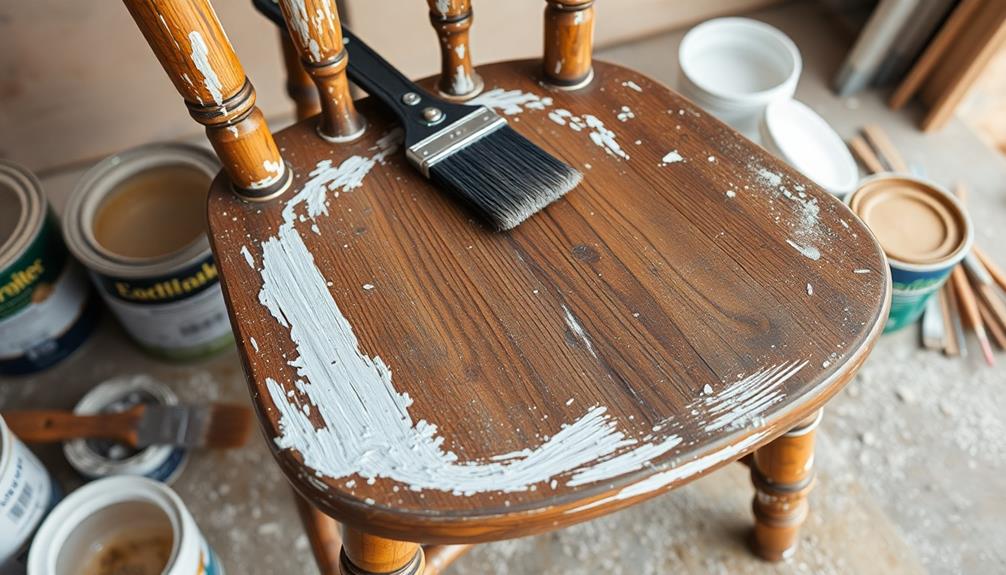
To begin the stripping process, choose a well-ventilated area and protect your workspace with a drop cloth.
Next, apply a generous coat of paint stripper, like Citristrip, using an old paintbrush. It's advisable to guarantee proper airflow around the unit to enhance performance while working, similar to how to maintain air purifier efficiency.
To enhance absorption, cover the area with Saran wrap and let it sit for a recommended time of 1 to 24 hours.
After the dwell time, check for paint bubbling and color change—these are indicators that it's ready. Use a paint scraper at a 30-degree angle to gently remove the softened paint. For intricate areas, steel wool can effectively scrape away stubborn spots.
Once you've stripped paint from wood, clean the surface with mineral spirits to remove any residue.
After the wood is completely dry, grab some 120-grit sandpaper. Sand in the direction of the grain to achieve a smooth finish.
Finally, give the wood a last wipe with mineral spirits to reveal a clean surface.
With these steps, you'll successfully remove paint from wood furniture and prepare it for its next chapter!
Safety Precautions to Follow
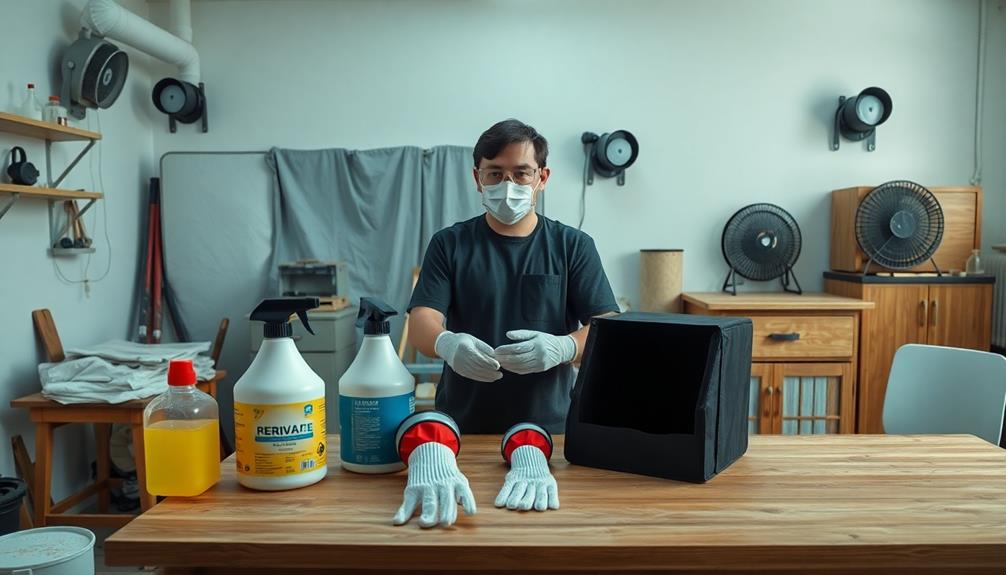
Stripping paint from wood furniture can be a rewarding project, but safety precautions shouldn't be overlooked. To guarantee your safety during the process, follow these essential guidelines:
- Always wear safety goggles and a mask to protect against dust and chemical fumes.
- Work in a space with proper ventilation, ideally outdoors or in a well-ventilated area, to minimize exposure to harmful vapors from paint strippers or heat guns.
- Keep a fire extinguisher nearby when using heat guns, as they can ignite flammable materials.
- If you're dealing with older furniture, use a lead paint test kit to check for hazardous lead-based paint, especially in homes built before 1978.
- Equip yourself with thick rubber gloves and disposable coveralls to protect your skin from chemicals and prevent contamination.
Final Touches and Refinishing
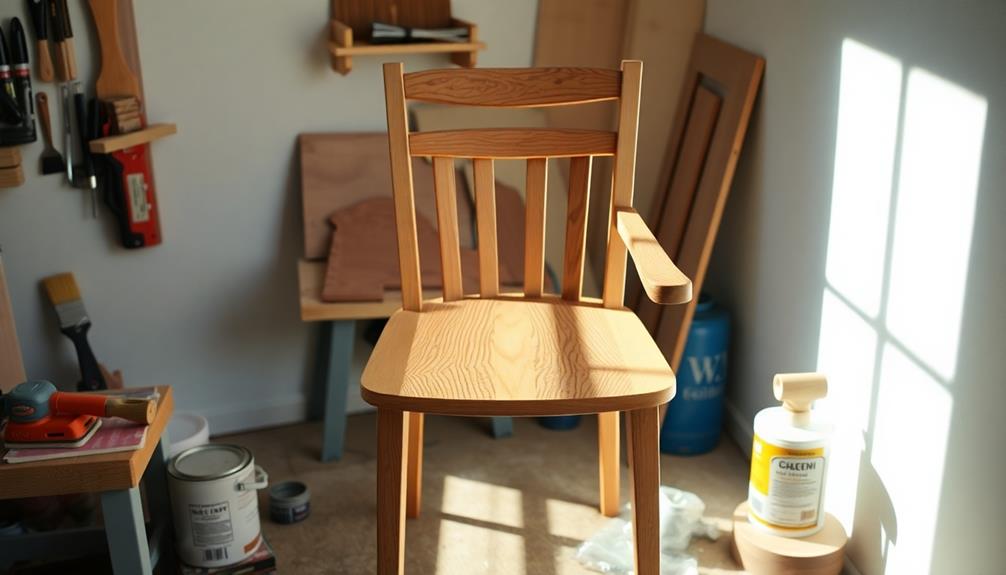
Once you've successfully stripped the paint from your wood furniture, it's vital to focus on the final touches and refinishing to bring out its natural beauty.
Begin by ensuring the wood is completely dry and free of dust. This step is fundamental to achieve a smooth surface and best adhesion of the finish. Use 120-grit sandpaper to gently sand the wood along the grain, removing any remaining paint and imperfections. Follow this with a higher grit, like 600, for finer details, cleaning the surface between passes.
Next, inspect all joints and drawer mechanisms for any warping or deterioration. Re-glue any loose joints to maintain the structural integrity of your refinished piece.
Once everything's in order, you can apply a protective finish, such as tung oil, in thin coats. Remember to allow at least 24 hours between each coat to prevent sticky buildup.
Frequently Asked Questions
What Is the Easiest Way to Remove Paint From Wood?
The easiest way to remove paint from wood is using a chemical paint stripper. Apply it generously, cover it, and let it sit. You'll find the paint dissolves, making your job much simpler and quicker.
How Do You Get Dried Paint off Furniture?
Did you know that about 25% of homes built before 1978 contain lead paint? To get dried paint off furniture, try using a paint stripper, heat gun, or sandpaper for effective results. Always prioritize safety!
Does Vinegar Remove Paint From Wood?
Yes, vinegar can remove paint from wood. Heat it, apply it to the painted area, and let it sit for a few minutes. Then, scrape the softened paint off. It's a safe, eco-friendly option!
What Is the Easiest Way to Strip Wood Furniture?
The easiest way to strip wood furniture is by using a chemical paint stripper. You’ll apply a thick coat, cover it with wrap, and let it sit overnight for ideal results. It’s simple and effective! After removing the paint or stain, make sure to thoroughly clean the surface to ensure that no residue remains, which could affect the new finish. Once the wood is prepped, you can start sanding it down for a smooth surface. For those looking for more guidance, consider researching refinishing wood furniture tips to help you achieve a professional look in your DIY project.
Conclusion
Removing paint from wood furniture might seem intimidating, but with the right method and tools, you can achieve stunning results. Don't worry if it feels overwhelming at first—many have successfully transformed their pieces with a little patience and effort. Remember, the satisfaction of revealing the wood's natural beauty is worth it. Plus, refinishing gives you the chance to customize your furniture just the way you want. So take the plunge—you'll be glad you did!
